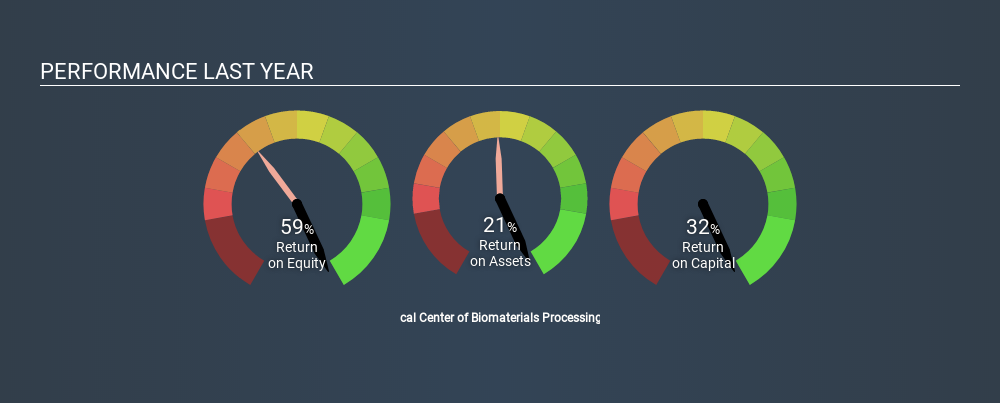- Russia
- /
- Healthcare Services
- /
- MISX:GEMA
Should You Be Excited About International Medical Center of Biomaterials Processing and Cryostorage Public Joint-stock company's (MCX:GEMA) 59% Return On Equity?

One of the best investments we can make is in our own knowledge and skill set. With that in mind, this article will work through how we can use Return On Equity (ROE) to better understand a business. By way of learning-by-doing, we'll look at ROE to gain a better understanding of International Medical Center of Biomaterials Processing and Cryostorage Public Joint-stock company (MCX:GEMA).
International Medical Center of Biomaterials Processing and Cryostorage has a ROE of 59%, based on the last twelve months. One way to conceptualize this, is that for each RUB1 of shareholders' equity it has, the company made RUB0.59 in profit.
View our latest analysis for International Medical Center of Biomaterials Processing and Cryostorage
How Do I Calculate ROE?
The formula for ROE is:
Return on Equity = Net Profit (from continuing operations) ÷ Shareholders' Equity
Or for International Medical Center of Biomaterials Processing and Cryostorage:
59% = ₽115m ÷ ₽194m (Based on the trailing twelve months to September 2019.)
It's easy to understand the 'net profit' part of that equation, but 'shareholders' equity' requires further explanation. It is all the money paid into the company from shareholders, plus any earnings retained. The easiest way to calculate shareholders' equity is to subtract the company's total liabilities from the total assets.
What Does ROE Mean?
Return on Equity measures a company's profitability against the profit it has kept for the business (plus any capital injections). The 'return' is the profit over the last twelve months. A higher profit will lead to a higher ROE. So, all else being equal, a high ROE is better than a low one. Clearly, then, one can use ROE to compare different companies.
Does International Medical Center of Biomaterials Processing and Cryostorage Have A Good Return On Equity?
Arguably the easiest way to assess company's ROE is to compare it with the average in its industry. The limitation of this approach is that some companies are quite different from others, even within the same industry classification. As you can see in the graphic below, International Medical Center of Biomaterials Processing and Cryostorage has a higher ROE than the average (10%) in the Healthcare industry.

That's clearly a positive. I usually take a closer look when a company has a better ROE than industry peers. For example, I often check if insiders have been buying shares.
Why You Should Consider Debt When Looking At ROE
Virtually all companies need money to invest in the business, to grow profits. That cash can come from retained earnings, issuing new shares (equity), or debt. In the case of the first and second options, the ROE will reflect this use of cash, for growth. In the latter case, the debt required for growth will boost returns, but will not impact the shareholders' equity. That will make the ROE look better than if no debt was used.
Combining International Medical Center of Biomaterials Processing and Cryostorage's Debt And Its 59% Return On Equity
International Medical Center of Biomaterials Processing and Cryostorage has a debt to equity ratio of 0.15, which is far from excessive. The combination of modest debt and a very impressive ROE does suggest that the business is high quality. Careful use of debt to boost returns is often very good for shareholders. However, it could reduce the company's ability to take advantage of future opportunities.
In Summary
Return on equity is one way we can compare the business quality of different companies. Companies that can achieve high returns on equity without too much debt are generally of good quality. If two companies have the same ROE, then I would generally prefer the one with less debt.
But ROE is just one piece of a bigger puzzle, since high quality businesses often trade on high multiples of earnings. It is important to consider other factors, such as future profit growth -- and how much investment is required going forward. So I think it may be worth checking this free this detailed graph of past earnings, revenue and cash flow.
Of course International Medical Center of Biomaterials Processing and Cryostorage may not be the best stock to buy. So you may wish to see this free collection of other companies that have high ROE and low debt.
If you spot an error that warrants correction, please contact the editor at editorial-team@simplywallst.com. This article by Simply Wall St is general in nature. It does not constitute a recommendation to buy or sell any stock, and does not take account of your objectives, or your financial situation. Simply Wall St has no position in the stocks mentioned.
We aim to bring you long-term focused research analysis driven by fundamental data. Note that our analysis may not factor in the latest price-sensitive company announcements or qualitative material. Thank you for reading.
About MISX:GEMA
International Medical Center of Biomaterials Processing and Cryostorage
International Medical Center of Biomaterials Processing and Cryostorage Public Joint-stock company operates as a licensed bank for personal storage of cord blood stem cells and tissue of the umbilical cord in Russia and the CIS countries.
Solid track record and good value.
Market Insights
Community Narratives





